1
ancestors and evolution
Insects are the most successful and diverse of all land animals. Their long evolutionary history has furnished them with uniquely adaptable bodies, capable of thriving in all environments. They have survived five mass extinctions, and many species have even surmounted the greatest challenge of all—successfully surviving alongside humanity.
1.4 • Insect evolutionary tree
1.5 • Carboniferous Earth: A land of giants

Trilobites were ancient arthropods and cousins to the insects—their segmented structure has proved an enduringly successful body-plan.
rise of the arthropods
Insects are invertebrate animals belonging to the larger group Arthropoda, meaning “jointed feet.” Their bodies also have movable joints at certain points on their rigid outer shell.
Humans, along with other mammals and all vertebrates, have an endoskeleton. The strong, rigid framework of bones is inside, with muscles, blood vessels, nerves, and other soft, fleshy structures around them. In insects, this anatomy is reversed. Their structural framework, the exoskeleton, is on the outside and the soft parts are within.
As well as insects, the arthropod group today includes crabs and other crustaceans, spiders and other arachnids, and the many-legged millipedes and centipedes. Their basic body-plan is bilateral symmetry, with left and right as mirror images, and the body is divided into many sections, called segments. The jointed legs and other limbs or appendages are in pairs along each side.
the exoskeleton
The first animal with a segmented exoskeleton and jointed limbs lived more than 540 million years ago, in the sea. Its appearance was a major event in evolution, introducing a very adaptable body arrangement. (An incidental benefit is that a strong, tough exoskeleton was much more likely to be preserved as a fossil—a huge help for our studies today.) The earliest fossil arthropods were small organisms, from the size of rice grains to grapes, and resembled a mix of worm and crustacean. But these remains are vague and difficult to classify.

Fossil trilobites: These early arthropods first appeared on Earth some 521 million years ago.
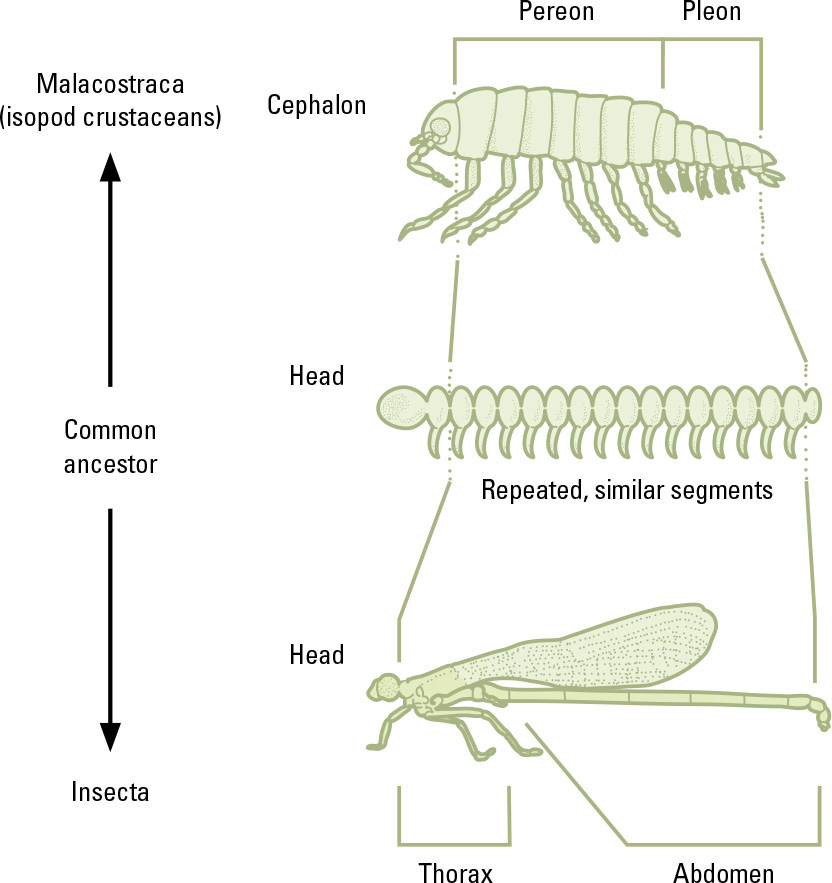
Modern arthropods like crustaceans (here an isopod) and insects (here a damselfly) both descend from an animal with simple repeated body-segments, each bearing jointed appendages.
Trilobites were swimming arthropods that lived in seas worldwide some 525 million years ago, during the Cambrian Period. The sea scorpions, or eurypterids, formed another prominent arthropod group. These fearsome predators first lived around 460 million years ago, in the Ordovician Period. Some, such as Jaekelopterus, were among the largest arthropods of all time, at 8 feet (2.5m) long. Both trilobites and eurypterids flourished for more than 200 million years, then gradually declined. The last of them died out in the Permian–Triassic mass extinction event, 252 million years ago.
onto land
Meanwhile, other arthropods had moved onto land, probably 430 to 450 million years ago during the Ordovician Period. Their basic body design and anatomy were already well suited to terrestrial life—a feature in evolutionary science known as preadaptation. The tough, impermeable exoskeleton greatly reduced body fluid loss in air, and the jointed limbs held up the body for moving around. Some of the first terrestrial arthropods were trigonotarbids, which were arachnids similar to their modern spider relatives. Mostly small, ⅕ to ⅘ inch (0.5 to 2cm) in length, they went extinct about 290 to 300 million years ago. A very different destiny awaited one of the next arthropod groups to colonize land—the insects.
the first insects?
In the Devonian Period, 359 to 419 million years ago, insects were spreading into early terrestrial habitats, helped along by pioneer plants, which established environments and food sources.
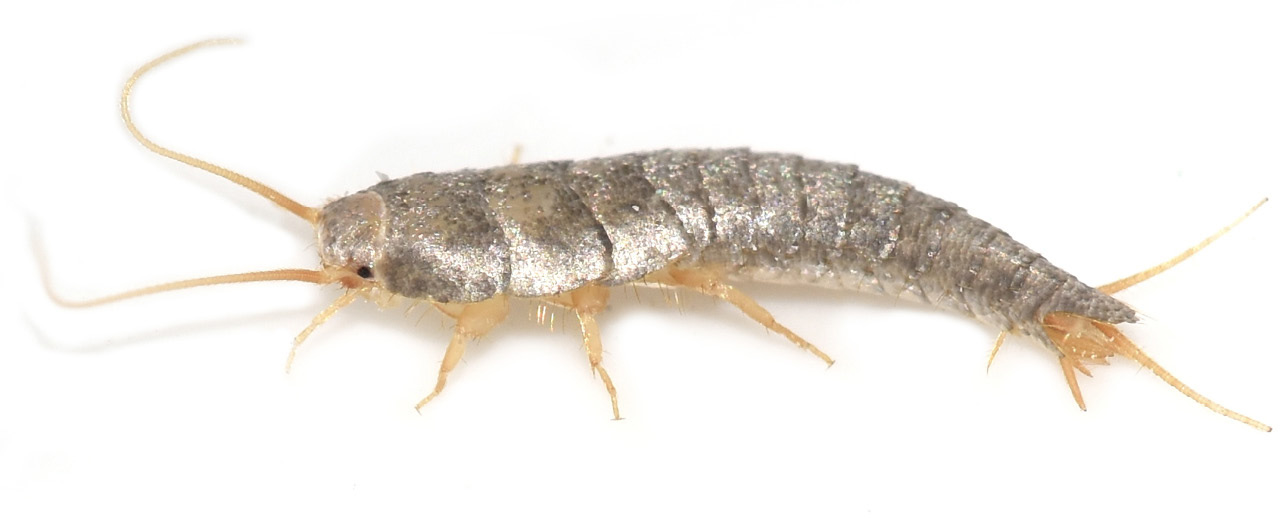
Silverfish have altered little in anatomy since their ancestors first appeared about 380 million years ago.
A single fossil, as small as this “o,” may be the oldest known insect fossil. The fossil in question is Rhyniognatha hirsti and is the subject of continuing debate. It consists of most of a tiny head but little else. It was excavated in 1919 from flintlike rocks called Rhynie chert, at a village near Aberdeen, Scotland. In 1926 it was interpreted as an arthropod, but as a springtail or collembolan, Rhyniella praecursor, a relative of true insects. In 1928, reexamination, especially of the mandibles—insect “jaws”—showed it to be a true insect and it was renamed Rhyniognatha hirsti. The specimen is dated to the early Devonian Period, 395 to 400 million years ago.
changing opinions
For decades Rhyniognatha was famous as the very earliest insect fossil. In 2002 it was reexamined using much improved microscopes. The verdict was that its mandibles moved with a scissorlike action, using two joints. This anatomy is found in the mandibles of flying insects, but not in non-fliers, which were assumed to have evolved first. The earliest fossils of flying insects do not appear until at least 70 to 80 million years after Rhyniognatha. So if Rhyniognatha was indeed a flier, this would push back the origins of insect flight many millions of years, and the beginnings of insects in general even further.
The Rhyniognatha specimen itself showed no wings, but this is unsurprising since it was originally preserved in a hot spring where tiny fragile wings were unlikely to survive. These 2002 studies suggested the whole creature resembled a mayfly that could rest on a human fingernail.
not an insect?
In 2017 there was another twist. The Rhyniognatha specimen was examined again using more advanced microscopes, which revealed previously overlooked fragments including additional mouthparts. The new conclusion was that Rhyniognatha was not an insect. The anatomy of the head parts, plus information about other arthropods present in the fossil-dig location at the time, meant it was more likely an early relative of centipedes. Perhaps future generations of microscopes and experts will settle the status of Rhyniognatha.
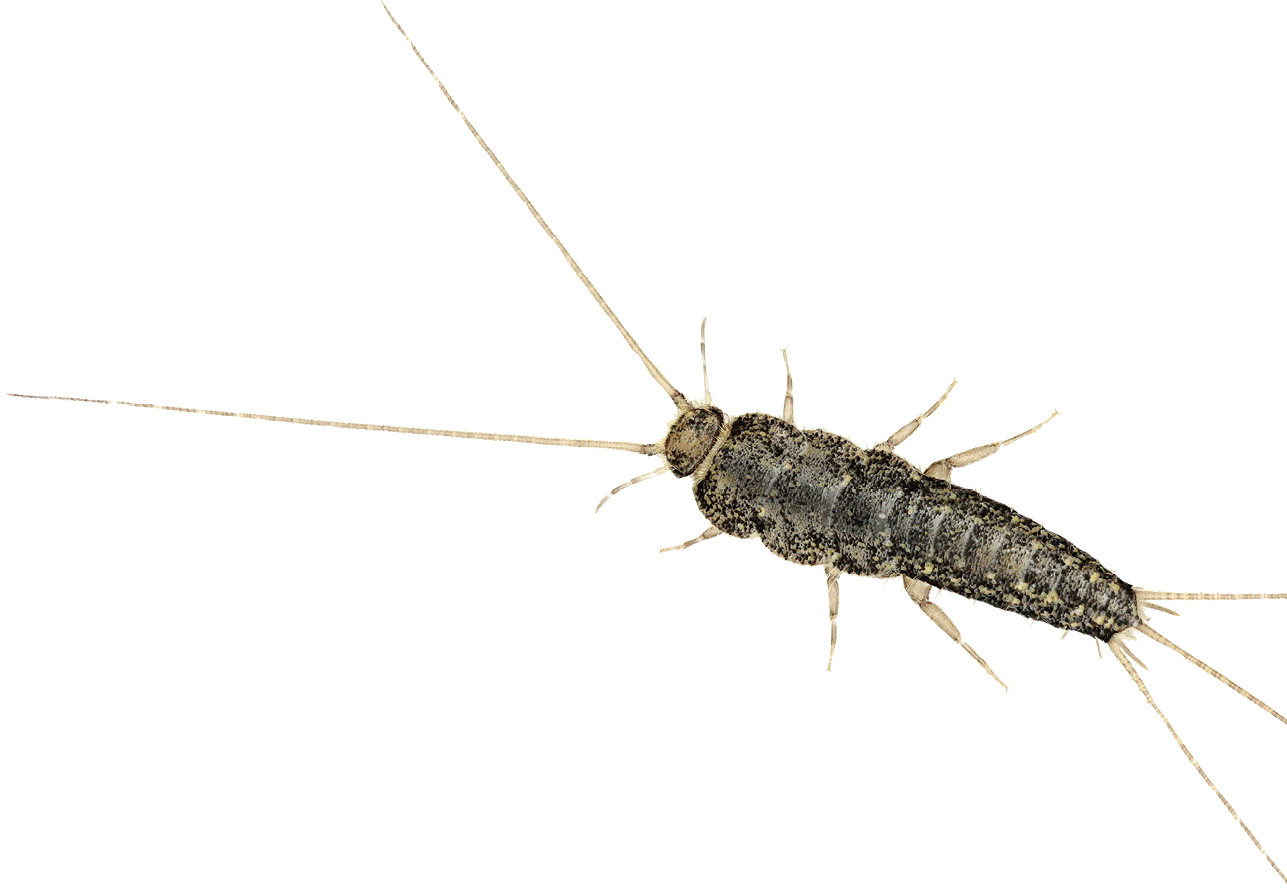
Firebrats are widespread primitive insects which often occur in hot, humid environments.
Fossils from about 380 million years ago onward, in eastern North America and gradually spreading to Eurasia, are generally accepted as early insects. They were wingless and came from the groups known as Archaeognatha (rock and jumping bristletails) and Zygentoma (silverfish and firebrats). These kinds of insects are known as “primitive,” which in biology means a form that arose early in evolutionary history and has changed or been modified little since.

The controversial fossilized mandibles of Rhyniognatha hirsti, which was a possible early insect.
It is not the case that evolution has passed them by, merely that environmental conditions that suit their survival have remained in more or less the same state for all those millennia. They have continued to evolve, but only to become better and better at living in the same way that they always have.
STUDYING INSECTS
Our understanding of what insects are made of and how they live their lives is constantly growing, thanks to the efforts of scientists working in labs and wild places all around the world.
The study of insects is called entomology. However, entomology as a field of study draws upon many other disciplines, too, including genetics, cell biology, comparative anatomy, ecology, biogeography, and biochemistry. To understand fully how any given species functions, we need to look not only at its anatomy and cellular structure and its physiological processes during its life cycle, but at how, as a living insect, it uses its environment and how it fits into ecosystems.
Insects lend themselves to study in the lab in many ways, as they are mostly small, easy to keep, and breed rapidly, so it is easy to obtain specimens for tissue samples, and easy to study living processes and behaviors under controlled conditions. Studying the activities of insects in the wild is a very different matter. Even tracking one individual’s movements over more than a few seconds can be impossible, although satellite tagging technology is evolving so rapidly that it may not be long before we can fit a flying insect with a tag light enough to allow it to fly unimpeded.
Ecology as a field of research has always drawn on data from “citizen science” projects, through the observations made by keen amateurs, and here is where nonspecialists have much to contribute to furthering our knowledge of insect behavior and distribution. Most of us will not be able to get our hands on an electron microscope or a DNA sequencing machine, but we can all head outside with a notebook and document what we see. In the US, for example, volunteers can take part in one of the North American Butterfly Association’s Butterfly Counts. This scheme, begun in 1975, now has 450 count sites, each a circle with a 15-mile (24 km) diameter, and compiles all butterfly observations from any point in the site over a one-day period. The resultant data has provided many insights into changes in butterfly abundance and distribution. Many other such schemes exist for other insect groups in other parts of the world.

Pond-dipping is a great way to study the aquatic larvae of insects such as mayflies, damselflies, and diving beetles.
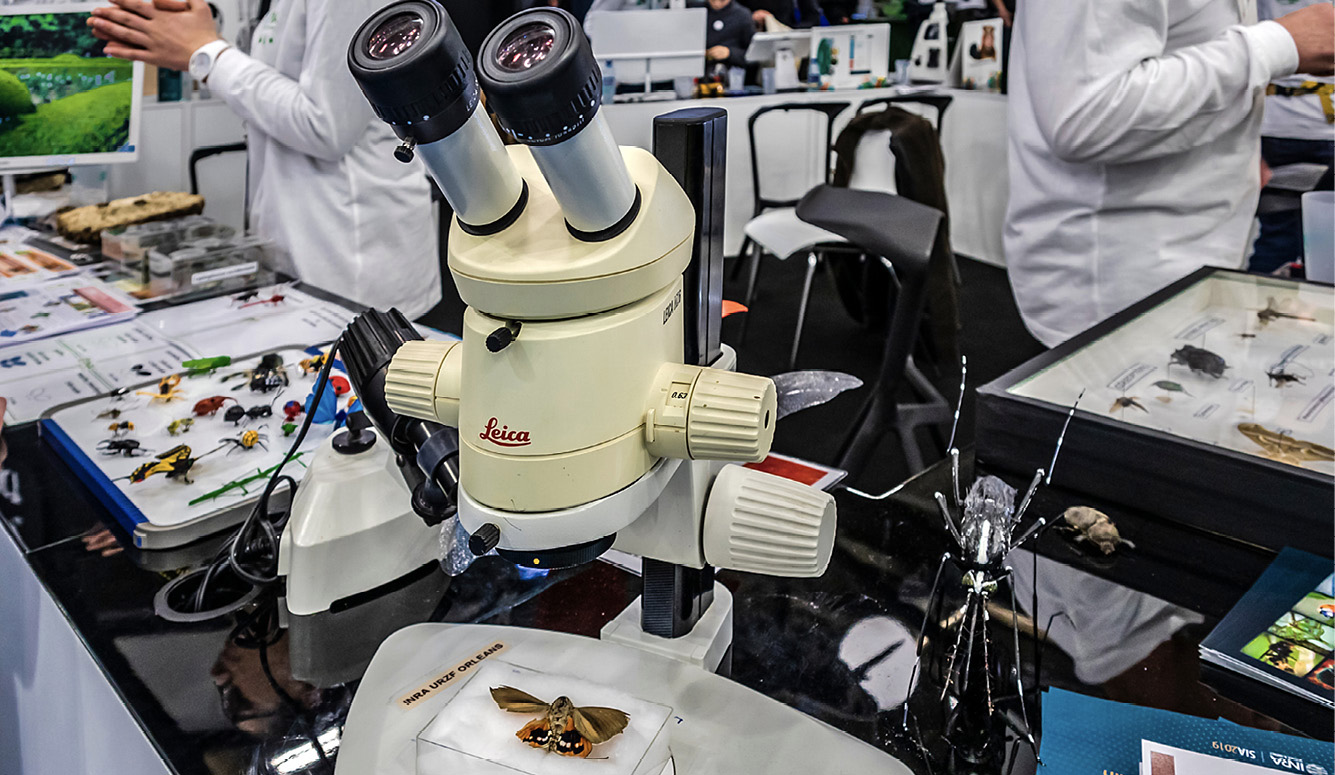
Some aspects of insect study involve lab work and the use of some very specialized equipment.

Any garden or outside space will offer plenty of interest for the amateur entomologist.
Team up
To further your own knowledge of insects and contribute to the body of work on insect biology and ecology, a good first step is to find your local entomology group. Most such groups are active on social media, and you may also find local groups that specialize in particular types of insects, as well as conservation organizations and local groups that work toward the well-being of all kinds of wildlife.
the first fliers
By the start of the Carboniferous Period, 359 million years ago, insects were widespread in many terrestrial habitats. However, only when flight evolved did they become a dominant force.
Three sets of living animals (and one extinct) have evolved true flight—sustained, self-powered, and controlled travel through the air. The groups are insects, birds, bats, and the extinct pterosaurs. Insects were the first by almost 200 million years—and perhaps much longer. In 2015, a study examining the mutation rate of modern insect DNA and other genetic material delved into insects’ deep evolutionary history. It concluded that they first arose nearly 500 million years ago, as the first plants were taking root on land, with winged insects appearing by 400 million years ago.
Traditionally, the whole insect group is divided into wingless apterygotes and winged pterygotes. It is commonly assumed that the apterygotes came first, although they may have had several evolutionary origins. The winged insects vastly outdo them today in variety and numbers and are believed to have had a single ancestral origin. This means that they form an evolutionary unit known as a clade.
ways to fly
In terms of anatomy, there are several ways that insects fly, as explained in more detail on later pages. Probably first to evolve was direct flight, as shown today by the mayflies, (Ephemeroptera), along with the dragonflies and damselflies (Odonata). The muscles that work the wings are attached between the inside base of the strong, boxlike thorax (the middle of an insect’s three body-sections) and the bases of the wings themselves, inside the thoracic wall. In other groups, indirect flight involves muscles attaching to the “roof” of the thorax that abruptly flex the whole thoracic casing. The thorax “snaps” to and fro between its two stable states (relaxed and flexed) to flick the wings up and then down.
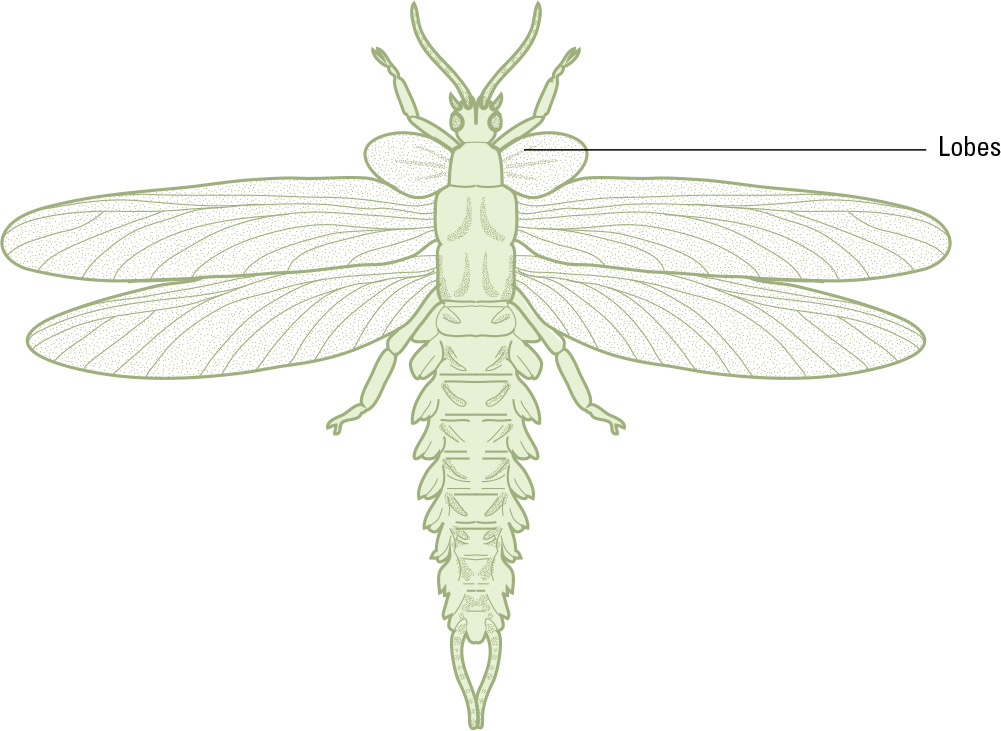
Palaeodictyoptera was an early order of winged insects, characterized by a pair of winglike lobes on the upper thorax in front of the true wings.
origins of insect flight
Insects’ two pairs of wings may have derived from flat protrusions on what were once early limbs or protuberances from the thoracic wall. At first these possibly came in handy for emergency parachuting, perhaps from taller plants to escape predators. Gradually the walking limb part of the design faded and the flanges enlarged, permitting more controlled gliding and eventually fully flapping flight.
By the beginning of the Permian Period, 299 million years ago, more than ten groups of flying insects had evolved, including mayflies, dragonflies, grasshoppers, cockroaches, and the palaeodictyopterids—a once extremely numerous and diverse group that died out by the end of the Permian.

True flies, such as mosquitoes, have one pair of wings, the other being reduced to knob-like halteres that help maintain stability in flight.
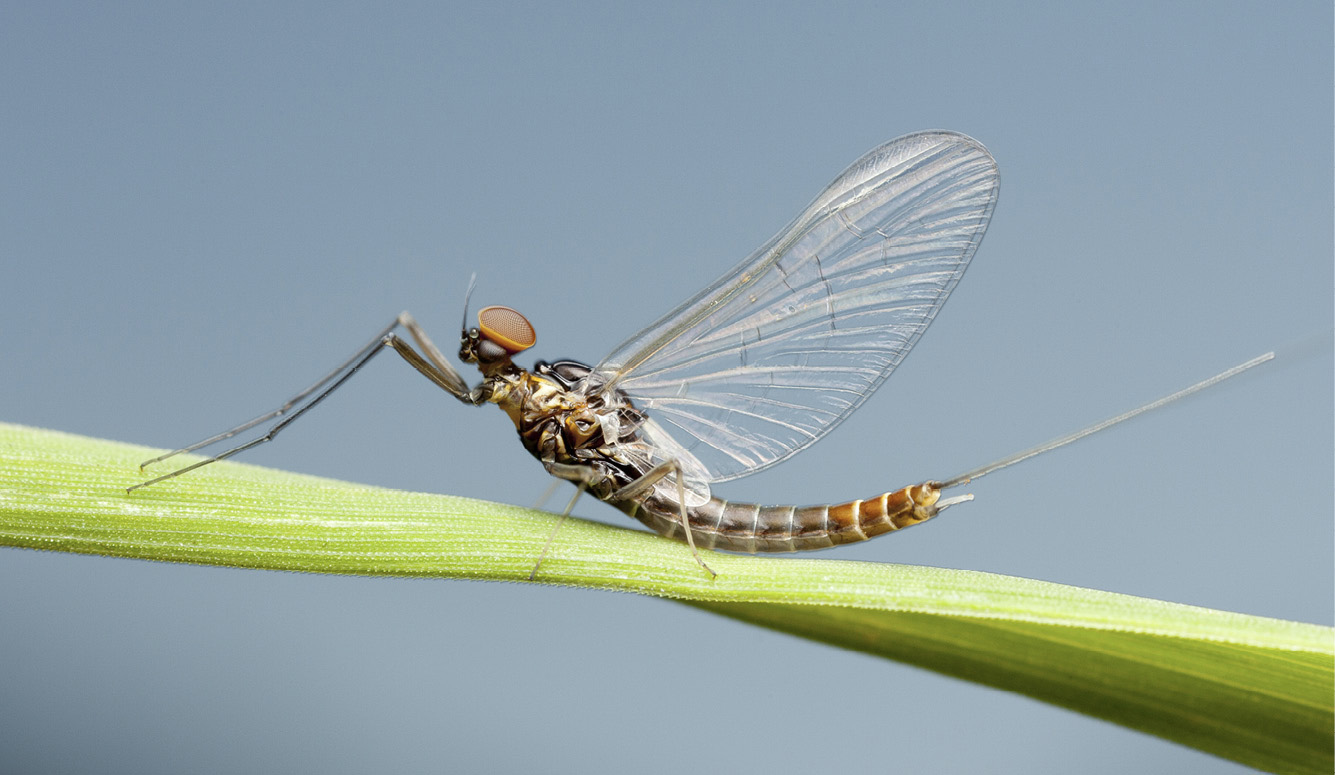
Mayflies have existed on Earth for nearly 300 million years—nearly twice as long as mammals.
insect evolutionary tree
Almost all adult insects have six legs. However, other arthropods also have six limbs or similar appendages, but they are not insects. With the insects (Insecta), they are part of the larger group Hexapoda (“six legs/feet”).
As well as insects, the hexapods include three other, far less numerous and less diverse groups. The collembolans, or springtails, leap great distances for their size using a flick-action “tail.” The proturans are tiny soil-dwellers nicknamed “coneheads.” The diplurans are known as two-pronged bristletails, referring to the two long extensions, cerci, at their rear ends. These three groups of wingless arthropods were once considered to be members of Insecta, but are now separated within Hexapoda.
The first true insects were wingless and, as mentioned previously, are represented today by two small subgroups, Archaeognatha (rock and jumping bristletails) and Zygentoma (silverfish and firebrats). Around 300 to 350 million years ago, during the Carboniferous Period, a surge of evolution saw several of the main insect subgroups established, including mayflies, dragonflies, and cockroaches.
new opportunities
When new sources of food, habitats, and other opportunities become available, evolution tends to progress rapidly in bursts called adaptive radiation. This happened several times for insects. Around 270 to 290 million years ago, the largest of all insect subgroups arose, the beetles and weevils, Coleoptera. Another subgroup dating from this time was the scorpionflies, Mecoptera. These mecopterans or their close relations had probably given rise to the two-winged or “true” flies, Diptera, by 240 to 250 million years ago.
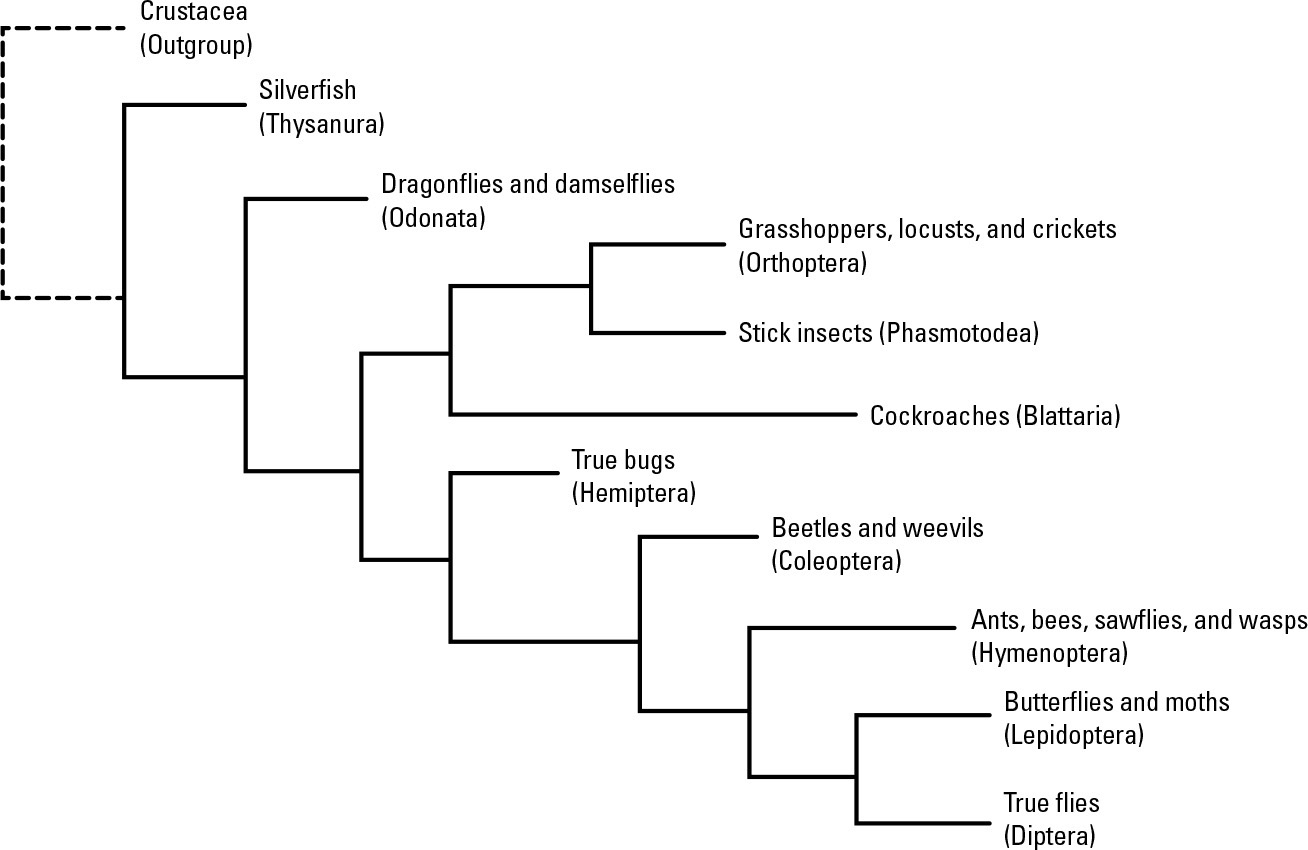
This cladogram shows the evolutionary relationships of most of the larger insect groups.
more insects evolve
Other lineages from mecopteran-like ancestors include the caddisflies, Trichoptera, appearing some 230 million years ago. Their close cousins the moths and (later) butterflies, Lepidoptera, arose around 180 to 200 million years ago. The fleas, Siphonaptera, are also part of this Mecoptera-based insect radiation, with early flea-like forms known by 150 million years ago.
Another major insect subgroup is Hymenoptera—the sawflies, wasps, bees, and ants. These lineages appeared alongside early dinosaurs in the Triassic Period, more than 220 million years ago. By the beginning of the Cretaceous Period, 145 million years ago, nearly all of today’s main insect subgroups were established.

A “conehead,” belonging to the order Protura: These arthropods are six-legged and are closely related to the insects.

Springtails and the other noninsect hexapods differ from true insects in several ways, including having internal rather than external mouthparts.
A PLACE ON THE TAXONOMIC TREE
How to classify life on Earth has preoccupied biologists for centuries. Through fossil evidence, comparative anatomy, biogeographical data, and genetics, we are building an accurate family tree for all living things.
The study of taxonomy concerns working out the evolutionary relationships of different animals. In the case of our own species, we have good evidence that the living animals most closely related to us are the chimpanzees, and that we and they both descend from an ancestral species that lived some six or seven million years ago.
Insects and other arthropods form a major subdivision of the animal kingdom—the group Arthropoda. Their closest living relatives are other invertebrate groups including the tardigrades or “water bears,” the nematode worms, and the velvet worms. Their shared ancestor, which lived more than 530 million years ago, would have been a marine animal with a soft, segmented, modular body. The earliest arthropod fossils date back about 510 million years.
Insects evolved from the first arthropods to begin to live on land around 419 million years ago. Traditionally, we classified insects and crustaceans as two distinct groups of arthropods, which went their separate evolutionary ways some 400 million years ago, evolving their distinct traits after this split. However, studies of DNA sequences in both groups have shown this is not the case, and that insects in fact evolved from one particular lineage of crustaceans. Modern insect and crustacean classification places them together in a group called Pancrustacea.
Studying taxonomy
The fine detail of anatomy is important in working out how closely related different animals are. Without this level of study, we might look just at superficial traits and make mistakes, such as thinking dolphins are fish, or bats are birds. Accurate dating of fossils is also important, showing when particular traits first appeared in a species’ lineage. Looking at biogeography can show us where certain groups originated and their patterns of spread around the world.
However, the study of DNA gives us our most powerful tool yet for studying relationships. Through comparing gene sequences, and applying our knowledge of gene mutation rates, we can work out how closely related two animals are, and how long ago their last shared ancestor had lived. This relatively new line of research is rapidly producing fresh insights into insect classification.
The scientific names we give to insects (denoting their species, genera, and families) reflect our current understanding of their relationships with other species (see here for more about this). New genetic research has led to the names of several insects being changed to reflect new knowledge, which means that field guides need to be regularly updated with any changes.

This simplified cladogram of the principal animal phyla, including appearances of key traits such as bilateral symmetry, shows where arthropods fit in alongside their closest relatives—the annelid or segmented worms. The key difference between protostomes and deuterostomes is in their embryology—in the former, the point where the early embryo first folds over is destined to become the mouth, but in deuterostomes it becomes the anus.
INSECT CLASSIFICATION
The main groupings of insects are known as orders, and there are about 30 different insect orders in the world. Each order is subdivided into several further categories.

The relationships within the insect order Odonata: Its two basic groups—the dragonflies and the damselflies—have a single common ancestor, and each branches off into several distinct families, some of which are shown above.
Classification in biology, sometimes referred to as taxonomy, is a difficult discipline. Real nature is not arranged in as orderly a manner as we would like. Arguments between taxonomists are frequent, and compromises have to be made to come up with a workable system.
Traditionally, an order is broken down into one or more families, the members of each family sharing particular traits. For example, the dragonfly order Odonata contains about 30 families, including Aeshnidae (the hawker dragonflies—large, parallel-edged bodies, fast-flying), Calopterygidae (the broad-winged damselflies, large with colored wing patches in the males), and Lestidae (the spread-winged damselflies—often metallic-colored, rest with wings held away from the body). Each family contains one or several genera, which share a narrower range of traits. For example, Aeshnidae includes the genera Anax, Aeshna, and Brachytron, which all show distinctly different head shapes in their larval form. Finally, within each genus there is one or more individual species.
This naming system sets out to group insects according to how closely they are related to other species and other groups—how long ago in evolutionary history they shared a common ancestor. However, evolution is a slow and gradual process, better visualized as a branching tree rather than a filing cabinet. We can introduce intermediate ranks for groupings that do not fit—suborder, superfamily, subgenus, superspecies, and so on. But today many biologists prefer an alternative approach, known as cladistics. This involves classing each branch of the evolutionary tree in a group together with all of its descendants, or offshoots. Each grouping is called a clade, whether it contains thousands of species (and genera, and families) or just a handful—the key thing is that the group always contains the common ancestor and every descendant, but none that descended from a different common ancestor.

The Green Darner, Anax junius
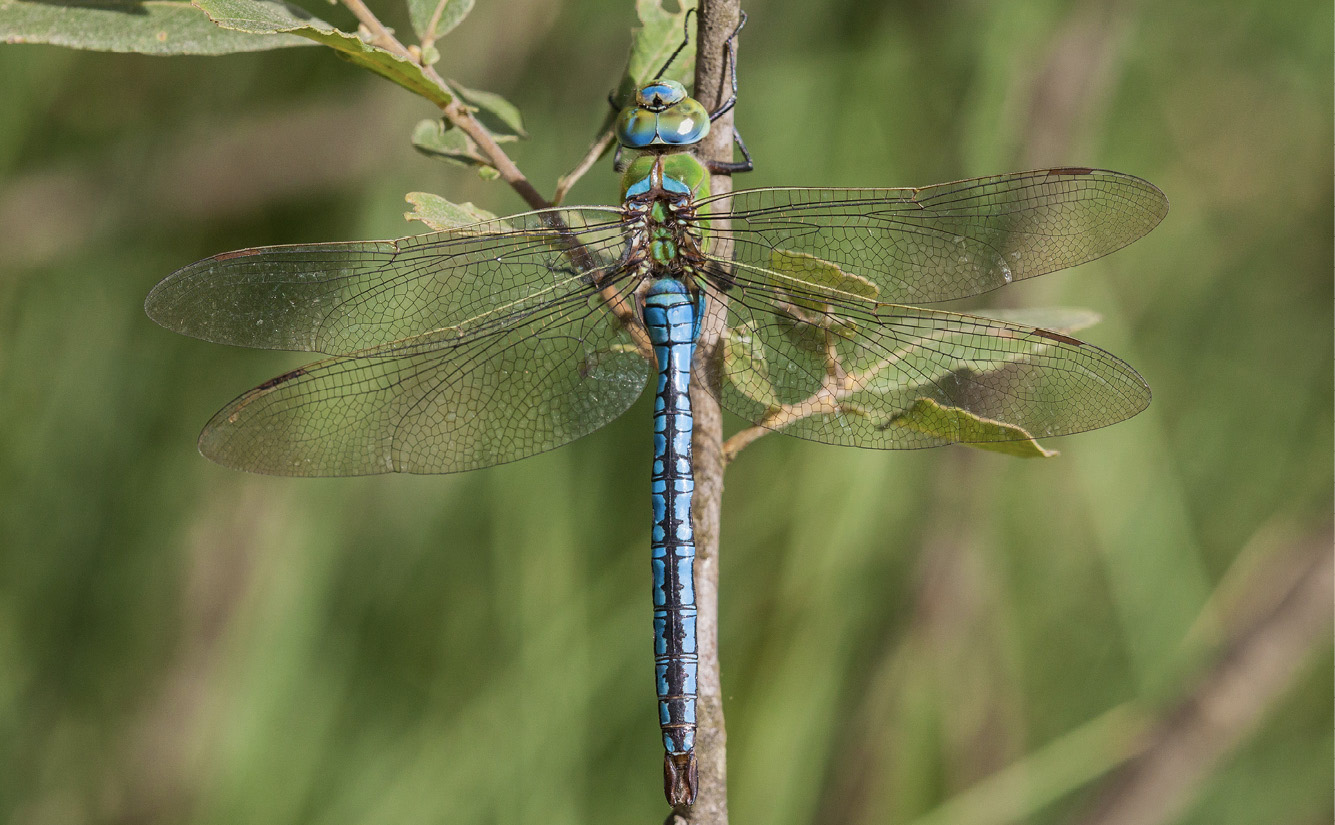
Emperor Dragonfly, Anax imperator, are found on opposite sides of the Atlantic, but their similar appearance shows their close relationship, which is reflected in their scientific names.
Scientific names
Even the most specific ranking level—species—is not always easily defined, but in general all members of a species can be distinguished because they all look more or less the same, and will breed with one another but avoid breeding with members of other species. In biology we designate species with a scientific name, formed from two words—for our own species the name is Homo sapiens, for the honeybee it is Apis mellifera, and so on. Regional names for insects can be very diverse, or entirely nonexistent, but every species described by science has a unique scientific name, which will be used in all countries.
carboniferous earth: a land of giants
The Carboniferous Period, 299 to 359 million years ago, saw life truly flourish on land. The first great forests formed, providing diverse new habitats and a more oxygen-rich atmosphere.
Temperatures, rainfall, and overall climates have fluctuated through Earth’s prehistory. The early Carboniferous saw average annual global temperatures rise to 68°F/20°C (compared to about 59°F/15°C today). Sea levels fell to expose more land, and rainfall was plentiful. Terrestrial plants proliferated and released vast quantities of oxygen into the air by the process of photosynthesis. Oxygen eventually made up 35 percent of Earth’s atmosphere, compared to today’s 21 percent. Land vertebrates were only just beginning to appear, but many groups of invertebrates thrived in these warm, humid, swamplike, tropical–rain forest conditions.
insect breathing system
As described later, insects and some other land arthropods obtain oxygen through a system of branching air tubes known as trachea. The higher the concentration of oxygen in air, the farther it can spread or diffuse along these tubes to reach the innermost body parts. This factor limits overall body size, so in the oxygen-rich Carboniferous atmosphere, insects’ bodies could be larger than they are today. Compared to modern insects, some Carboniferous insects evolved into giants.
The biggest were cousins of today’s dragonflies, sometimes known as griffinflies. Meganeura and Megatypus were the all-time largest invertebrate fliers. Their wingspans reached 28 inches (70cm), almost that of a crow. Like modern dragonflies they were fierce, powerful aerial predators with spiky mandibles and strong legs to seize prey in midair.
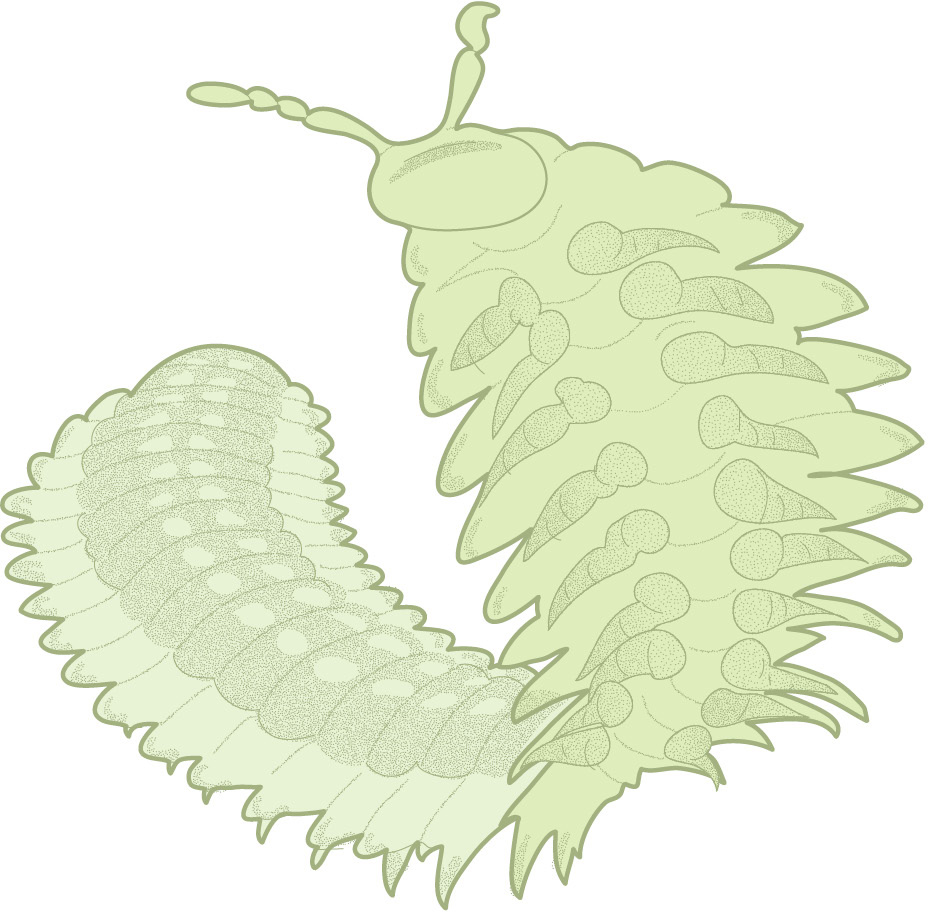
Arthropleura was a genus of Carboniferous millipedes, some of which exceeded 7 feet (2m) in length.

This reconstructed Carboniferous scene features an Arthropleura millipede and a crow-sized griffinfly.
more giants
Among the griffinflies’ victims may have been more sizable fliers, palaeodictyopterids. These vaguely resembled giant mayflies but form their own distinct insect group, which had died out by 250 million years ago. Their wings spanned more than 20 inches (50cm). Unlike griffinflies, they had long, sharp, piercing mouthparts and probably sucked plant sap and similar juices, rather like modern “true bugs” (Hemiptera). However, some might have used their sharp mouths to extract blood or other fluids from animals. The presence of a pair of small, flap-like lobes on the first segment of the thorax, just in front of the two main pairs of wings, gives them the casual name of “six-winged insects.” Other large insects from the Carboniferous include cockroaches rivaling today’s largest, and bulky mayflies.
As the Carboniferous progressed, the climate continued to change. It became cooler and drier, and by 300 to 305 million years ago an event known as the Carboniferous Rainforest Collapse (CRC) led to fewer trees and other plants, and less atmospheric oxygen. The era of giant insects and other huge invertebrates faded.
recent evolution
Although some insect groups seem almost unchanged from their Carboniferous ancestors, adaptation through evolution doesn’t stop. Insects can adapt to change and new opportunities over relatively short time frames.

The wetas (families Anostostomatidae and Rhaphidophoridae) are unusual flightless relatives of grasshoppers and crickets, and are found only in New Zealand.
As we have seen, most modern insect groups first appeared during the Permian Period. Many of the insects on Earth 60 million years ago have very close relatives living today. Mosquitoes preserved in tree amber from Jurassic times may not hold the key to resurrecting the dinosaurs, but it is quite possible that they played a role in the mighty reptiles’ extinction by spreading malaria, just as they do among vertebrate animals today.
Throughout the 300 million years since the beginning of the Permian Period, the actual configuration of Earth’s landmasses has changed considerably, due to tectonic movement. These changes affected global temperatures, sea level, and rainfall, which in turn affected plant distribution and abundance. The supercontinent Pangaea had reconfigured into seven continents by some 100 million years ago, and the seas and oceans in between are barriers to the spread of insects. Today, while many insect groups can be found over all the temperate and tropical landmasses, most individual species are confined to much smaller regions.
New habitats lead to new opportunities for specialization. A new subspecies of mosquito (Culex molestus), was able to evolve in manmade environments—notably the London Underground, where it feeds on the blood of human commuters.
super-specialization
Predatory insects such as dragonflies will feed on any prey that they can capture, but plant-eating, nectar-eating, and parasitic insects are often much more specialized. Specialization is a key driver for evolution. For example, a plant species that is targeted by a particular species of moth may gradually evolve physical and chemical defenses against the moth’s foliage-eating caterpillars, such as spines on its leaves and toxic compounds stored in its cells. Over time and many generations, the moth caterpillars may evolve responses to these defenses, such as stronger mouthparts to cope with leaf spines, and resistance to the toxin. Eventually the moth caterpillars can only feed on that one particular plant species, as their adaptations do not equip them to feed on any other.
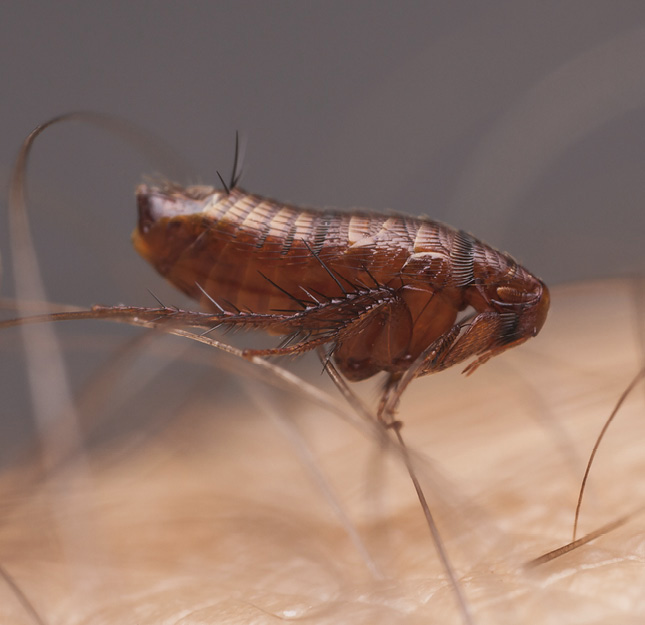
Fleas appeared relatively recently in evolutionary history, coevolving with their vertebrate hosts.
The same is true of parasitic insects, which involve a living animal host in their life cycles. Those that pursue this way of life include various wasps, which supply their larvae with a stung and paralyzed prey item, as well as fleas and louse flies, which spend their entire lives on their hosts’ bodies, feeding on blood or other body tissues.
Evolutionary specialization can also be seen in the relationship between flowering plants and their insect pollinators, with flowers evolving colors (including within the ultraviolet spectrum) and structures to attract the insects on which they depend.

Most members of the order Lepidoptera (butterflies and moths) feed on flower nectar in their adult form.
INSECT DISTRIBUTION AROUND THE WORLD
Insects are fabulously abundant on our planet, even today with all wildlife so beleaguered by multiple threats. However, some regions support far more insects than others.
There are estimated to be about 10 quintillion (10 followed by 18 zeros) insects alive on Earth at any given moment. Some of them belong to the 900,000 or so known species. The number of species that we have yet to discover is likely to be very high—conservative estimates begin at about 225,000 species, but most authorities consider the number of undescribed insect species to be nearer to 4 million. It could even be as high as 30 million, by some estimates.
Abundance of insects (species and individuals) is very closely tied to the abundance and variety of plant species. Many plant-eating insects are strict specialists, feeding on only one or a few species of plants. So lushly vegetated areas with a great diversity of plant types will support more different kinds of herbivorous insects, which in turn provide food for a wider range of carnivorous and scavenging insects, and other animals. However, areas under cultivation, though they may appear green and lush, will support only those insects that can eat that particular species of crop (and only if the crop is not being treated with insecticides).
Plant biodiversity worldwide

Regions where plant diversity (and therefore insect diversity) is highest on Earth: The areas of greatest diversity are close to the equator, and concentrated in the most heavily forested areas.

Vast tracts of species-rich rain forest have been cleared in tropical regions to make space for palm oil plantations, which can only reduce biodiversity.
The regions with the highest plant diversity are the tropics. However, these areas are also relatively little-studied compared to more populated temperate areas. Brazil has about 9 percent of all described insect species in the world, while India has approximately 6 percent. However, these countries are likely to hold far more undescribed than described species. The United States, with its huge land area, has about 91,000 described insect species, some 10 percent of the total, but its habitats are far better studied and the “unknown” list is therefore probably much shorter. The UK has some 24,000 described species, while Australia has about 75,000 named species and probably at least 100,000 that are yet to be described
Polar pioneers
Biodiversity on land, in general, is highest at the equator and decreases toward the Poles, with relatively few species and many groups missing altogether (although polar regions can still support huge numbers of individual animals). Insects, being land animals without the ability to thermoregulate, are extremely rare in polar areas—only those with a highly effective strategy to survive very long, very cold winters, with fresh water rarely available, can succeed. Among them are the Antarctic midge (Belgica antarctica), a flightless midge that is uniquely cold-adapted and is the only insect native to the Antarctic continent.
At the other end of the planet, the Arctic Wooly Bear Moth (Gynaephora groenlandica) lives in the high Arctic and spends most of its life as an inactive larva, freezing solid at times as it hibernates through temperatures that drop as low as –94°F (–70°C).
INSECTS AS BIOINDICATORS
With so much of the natural world under threat, it is important to spot the signs of an ecosystem that is struggling, and insects often act as biological indicators in this way.
You can learn a lot about the health of a habitat by studying the animals that are living in it, and by noting which ones “should” be present, but are not. Some insects are highly tolerant of degraded habitats, or indeed are adapted to do best in habitats where resources are very limited, so will survive in damaged habitats. But others are highly sensitive to habitat damage and the presence of pollutants and other harmful substances, and if we notice a drop in their numbers, this provides an early warning, which, if heeded, will help prevent further harm and loss of biodiversity.
Waterways are at high risk of damage from pollution, and this affects the insects that live in them during their larval stages. Stoneflies, mayflies, and caddisflies are particularly sensitive to this. In the UK, their numbers are monitored carefully on several rivers, by amateur volunteers (including anglers) as well as biologists, under the Riverfly Monitoring Initiative. Volunteers can use special pond-dipping equipment to look for larval insects, and they can submit records of the adult insects that they see.

Pollution in waterways affects many species of insects, though some are highly tolerant of polluted water.
Some toxins and pollutants can accumulate in the food chain. This was the case with DDT, a pesticide once widely used to control crop-eating insects. It persisted in insects’ bodies and in the bodies of insect-eating animals, and eventually led to severe declines in many bird species across northern Europe and North America. Today, insects are often used as an indicator of the concentration of poisons such as heavy metals in industrial areas. Biologists capture insects of a particular species and examine their tissues for traces of the target pollutant.

The Migrant Hawker Dragonfly, once a rare visitor to the UK, has rapidly spread northward, which has influenced the distribution of other wildlife with ecological links to dragonflies.
Climate change
Shifts in insect distribution, and changes in timing of life-cycle events, provide evidence of ongoing climate change. In western Europe, a number of dragonflies and damselflies have been pushing their distribution northward over the last couple of decades. This has an impact on other species. For example, the northward spread of the Migrant Hawker Dragonfly (Aeshna mixta) has led to a similar spread in the Hobby, a small falcon that hunts dragonflies. Migrant Hawkers fly in early fall, which greatly benefits the Hobby as this is when the fledglings are beginning to hunt for themselves.
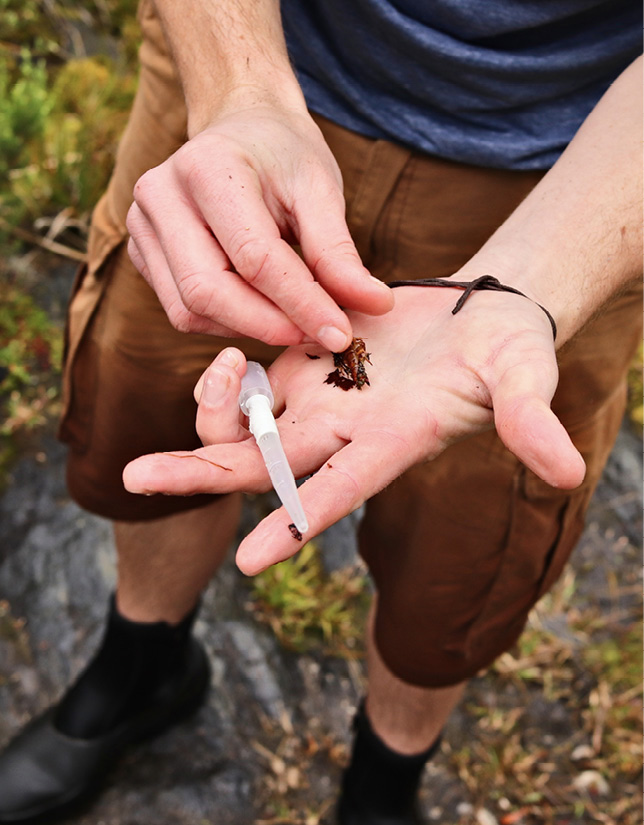
Studying changes in distribution of wildlife means taking samples from the same study area at regular intervals.